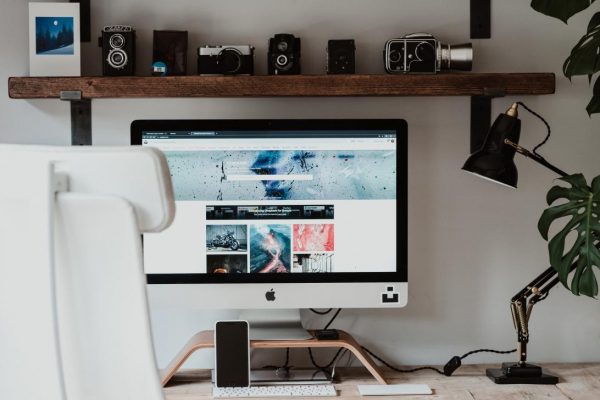 Please scroll down for the BSL translation of this article.
Please scroll down for the BSL translation of this article.
The COVID-19 global pandemic and ongoing lockdown restrictions have forced most of us to change the way we live and creatively adapt to the crisis.
Deaf and hard-of-hearing people living under the COVID-19 lockdown face a unique set of challenges. With every challenge, comes an opportunity and Coronavirus is no different. We can get through this. We all just need access to the right tools to do so.
Here are 5 tips for deaf people living through the COVID-19 crisis. If you know or work with a deaf person, it helps to be aware of the unique Coronavirus challenges they face and know how best to support them.
1. Working/studying from home

COVID-19 has forced many of us to bring the office home. If you are finding it hard to keep work-life boundaries separate, it’s a good idea to make a dedicated work area in your home.
Invest in some quality technology, faster internet and comfortable office furniture. To stay focused, take regular breaks, stretch and exercise.
Working in your pyjamas from bed might be okay in the short term but if your pillow doubles up as your desk you might find it harder to unwind.
Switching our corporate wardrobes for more comfy clothes is a definite positive of the lockdown but sticking to the routine of dressing for work each morning will help you stay productive.
2. Staying in touch with people

COVID-19 has also forced many of us to use video-call technology instead of face-to-face meetings. This kind of communication poses a unique challenge for deaf and hard-of-hearing people.
The video-call company Zoom has seen a huge user uptake since the COVID-19 outbreak. For people living with hearing loss, Zoom has some useful accessibility features like closed captioning (subtitles) and automatic transcripts.
If you are communicating with a deaf person on Zoom, you can make it easier for them to lip-read/read your facial expressions by staying face-on in front of the video, ensuring your mouth isn’t covered and ensuring that there is good lighting in the room so the video quality is the best it can be.
If you are using a sign language interpreter(s) in Zoom, remember to pin the interpreter in speaker view, so when the spotlight changes, you don’t lose the interpreter.
3. Wearing accessible face masks

Wearing a face mask correctly in public places helps to stop the spread, protecting essential workers and people who are most vulnerable to COVID-19.
Face masks make it very difficult for those in the deaf and hard of hearing community who rely on lip-reading and facial expressions to communicate.
The solution? A transparent face mask . The shortage of essential medical supplies like face masks has sparked many people to make their own at home. You can also DIY your own transparent face mask. Check out this step-by-step video tutorial: https://www.youtube.com/watch?v=w2_fzooIKNU
Or you can buy an accessible facemask here.
4. Learning new skills online

When an employer asks you how you spent your time during COVID-19, what will you say?
If you find yourself with more time on your hands under the COVID-19 lockdown, building in-demand professional skills will look very impressive on your resume.
EDX is one of the many online services which offers free accessible digital courses in topics that range from computer science, to structural engineering, to Shakespeare.
You can also have a night in at the theatre with the Deaf Theatre Company whose free online performances of Shakespeare’s plays in sign language are an enriching way to pass the time.
If you are looking to support the deaf community, you could also take the time to learn sign language.
5. Looking after your mental health

With a seemingly endless bad news cycle around Coronavirus and the emotional stress caused by social isolation, it is no surprise that anxiety and depression levels are higher than normal.
Many deaf people are already familiar with feelings of isolation as a result of societal stigma, prejudice and communication challenges. Before COVID-19, the deaf community already struggled with mental health issues at approximately twice the rate of the hearing population.
It’s so important that while focusing on protecting our physical health we don’t neglect our mental health during this stressful time. Mental Health UK has some useful online resources to help manage the anxiety that many of us are feeling.
Deaf people with mental health issues face more barriers to getting help than hearing people. Sign Health and Deaf4Deaf are fantastic services that offer mental health support and tips for deaf people
3 takeaways from this article:
- The COVID-19 pandemic presents a unique set of challenges for deaf and hard-of-hearing people, but there are some ways to help make sure we can get through it together.
- It’s important for us to consider the accessibility of technology and medical resources (like zoom calls and facemasks), and whether these can be adapted to aid the deaf community.
- To stay healthy and productive, try sticking to a routine and taking advantage of online resources for deaf learning, entertainment and looking after your mental health.
Accessible Resources
If you need accessible COVID-19 updates, BSL Zone are providing BSL coverage as well as a helpful series named Life in Lockdown that follows deaf people’s experiences during the pandemic.
For ASL users, the University of Rochester Medical Centre has provided a helpful resource page with links to COVID-19 information across the United States.
BSL Translation of this article
Here, we’ve translated the main takeaways of this article in BSL.


Since it is not what face mask I wear, it is the face mask the person I’m communicating with that is the barrier to my ability to know what someone is saying. How do I deal with that if they aren’t allowed to lower mask to talk? For the other person to raise their voice, or yell louder, does no good as I rely on reading lips.
Hey there – I just saw this on the UK’s National Deaf Children’s Society website – https://www.ndcs.org.uk/media/5916/infographic-communication-tips-for-facemasks-and-coverings.pdf – its an infographic you could take tips from. Also, share at your workplace or with friends etc. I use Otter.ai as a voice to text app but there are so many, I think Apple now has a native app for transcribing too. Its not a solution, but it is an option.